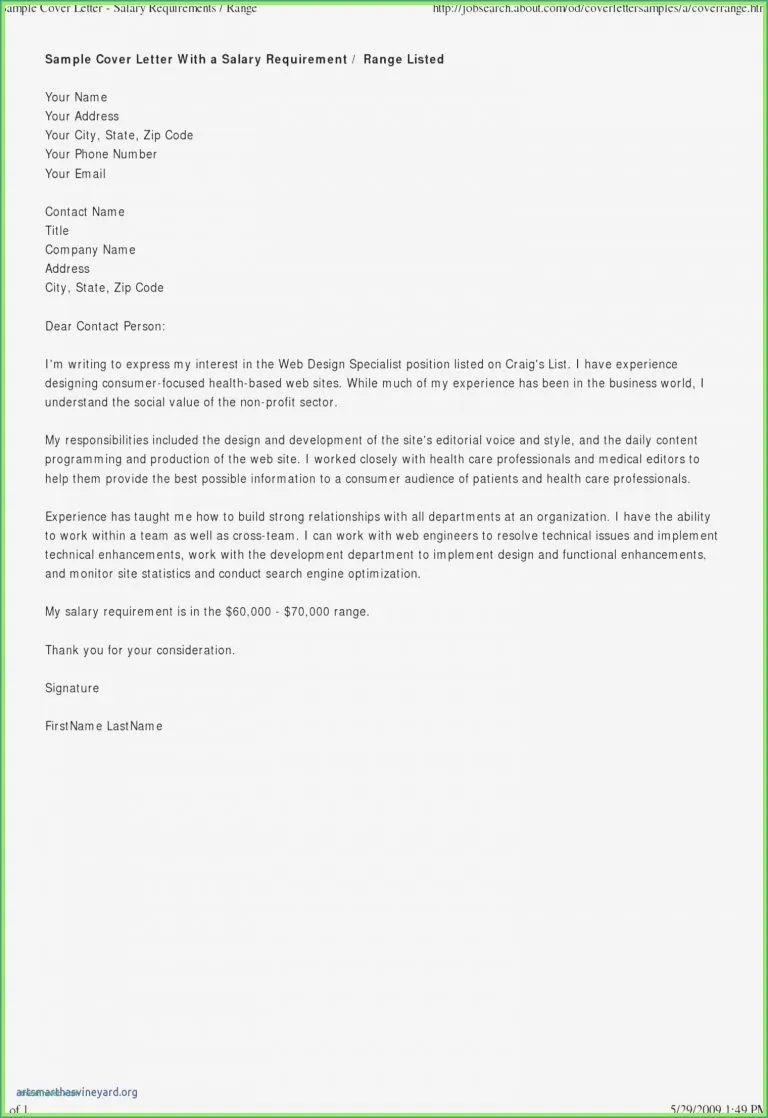Understanding the Importance of a Design Cover Letter
In the competitive world of design, a compelling cover letter can be your golden ticket to landing your dream job. It’s more than just a formality; it’s your chance to make a strong first impression and showcase your personality, skills, and passion. A well-crafted cover letter allows you to go beyond the constraints of your resume and provide a narrative that captures the hiring manager’s attention. It provides context to your experience, explains your design philosophy, and demonstrates why you’re the perfect fit for the specific role and company. Without a cover letter, you might be missing out on the opportunity to distinguish yourself from other talented applicants, ultimately hindering your chances of securing an interview and a job offer.
Why a Cover Letter Matters for Designers
Design is a visual field, and a cover letter is one of the few opportunities to communicate your ideas, personality and skills in words before your portfolio is reviewed. While your portfolio showcases your design abilities, the cover letter provides the context. It helps you explain your design choices, the problems you solved, and the results you achieved. In a market crowded with creative talent, this is your opportunity to stand out. It allows you to highlight specific projects from your portfolio that align with the job description and illustrate how your experience matches the employer’s needs. It’s your chance to show that you understand the company’s values and the specific requirements of the position, demonstrating your genuine interest beyond a generic application.
Making a Strong First Impression
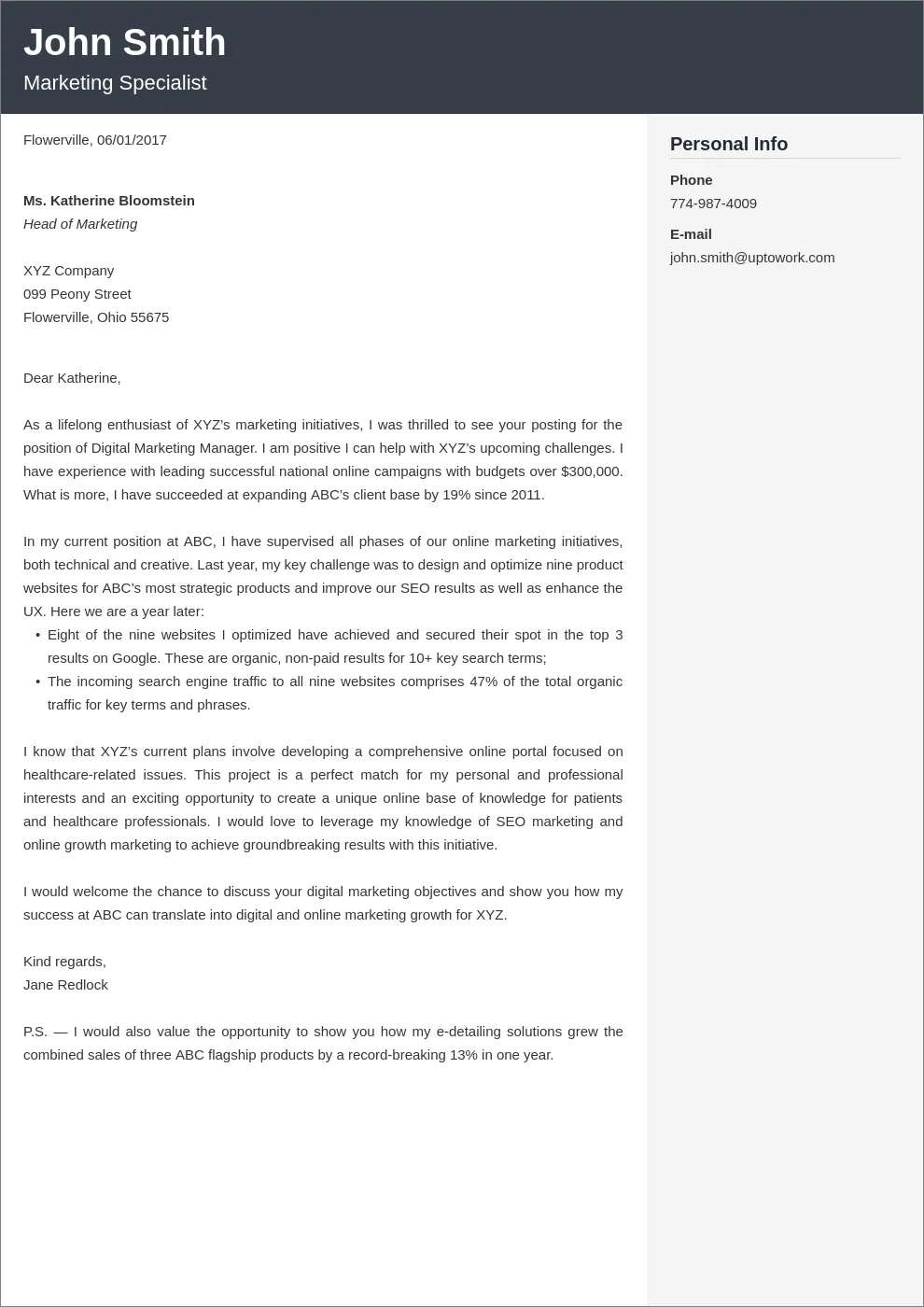
The first few sentences of your cover letter are crucial. They must grab the reader’s attention and make them want to learn more. Start with a strong opening that immediately highlights your enthusiasm for the role and the company. Briefly mention a specific project or achievement that’s relevant to the job, demonstrating you’ve done your homework and understand their needs. Avoid generic opening lines like “I am writing to apply.” Instead, opt for a statement that reflects your excitement about the opportunity. A well-crafted introduction sets the tone for the rest of your letter, ensuring the hiring manager feels compelled to continue reading and learn more about your unique qualifications and your design approach. A captivating start signals your professionality, and your ability to communicate effectively.
Top 7 Design Cover Letter Tips
Highlight Your Unique Design Skills
Your cover letter isn’t just a recap of your resume; it’s an opportunity to highlight specific design skills that make you stand out. Go beyond listing your software proficiencies (e.g., Adobe Creative Suite, Sketch, Figma). Instead, emphasize how you apply those skills. Give examples of your skills in practice. Did you lead a user research project? Did you create a brand identity from scratch? Quantify your abilities whenever possible – e.g., “Increased user engagement by 20% through innovative UI design.” Showcase your expertise in areas relevant to the job description. A strong design cover letter reveals your specific skill set relevant to the job.
Showcase Your Relevant Experience
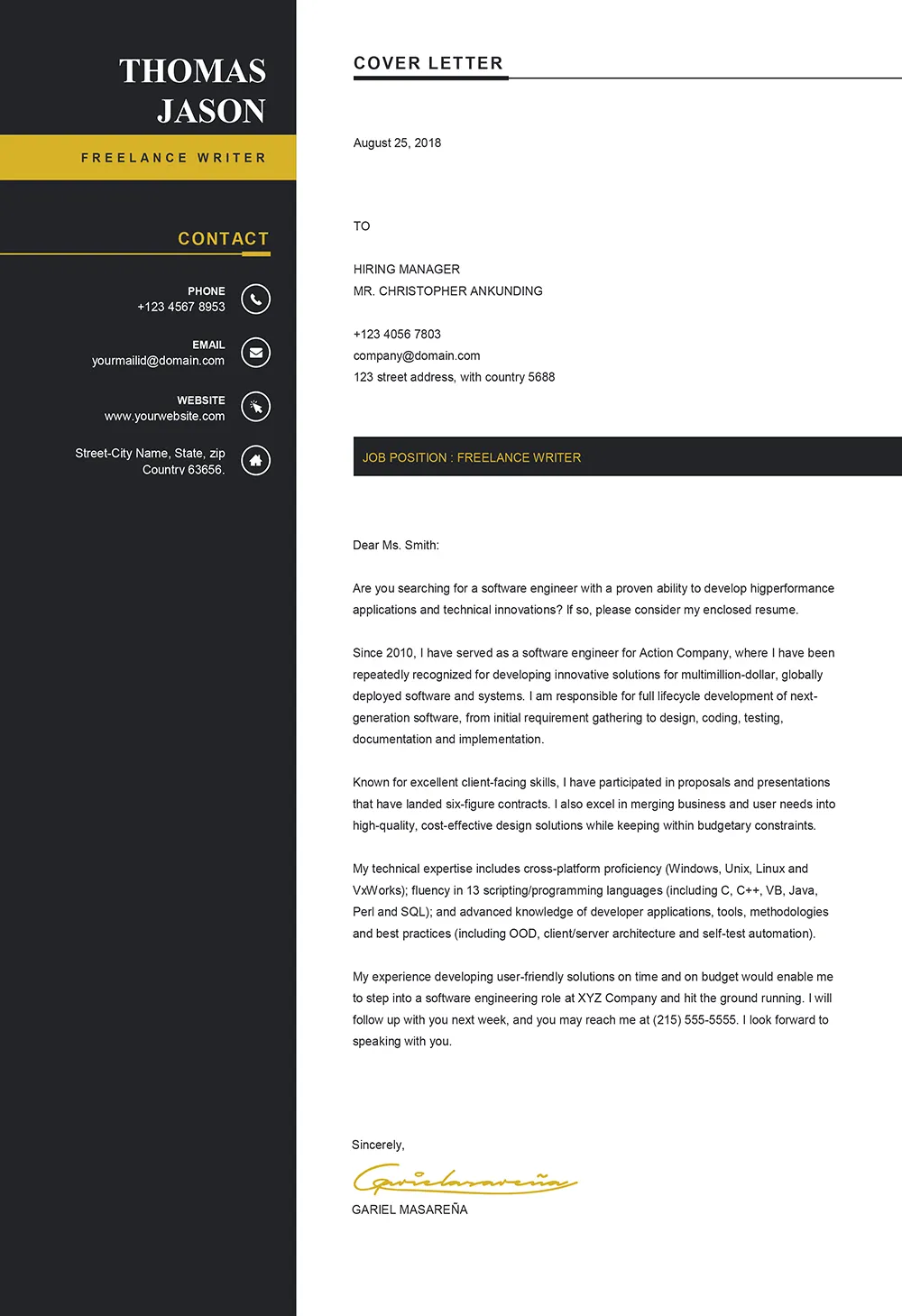
Focus on experiences that directly relate to the job you’re applying for. While it’s tempting to include everything, it’s more impactful to choose projects that align with the role’s requirements. Provide specific examples of your work, highlighting the problems you solved, the design processes you employed, and the outcomes you achieved. For instance, if the job requires experience with responsive design, detail a project where you successfully designed a website for multiple devices. Mention any awards or recognitions you received for your work, as this boosts your credibility. Ensure that the experience showcased is tailored to the company’s needs and the responsibilities outlined in the job description.
Tailor Your Letter to the Specific Job
Generic cover letters are easily spotted and often discarded. Customization is key. Before writing, carefully read the job description and identify the key requirements, skills, and company values. Then, tailor your cover letter to demonstrate how your experience aligns with these specific needs. Use the same keywords and phrases from the job posting to show that you understand what the employer is looking for. Demonstrate how your previous projects or experiences directly address the challenges and goals outlined in the description. This level of customization shows your genuine interest and your ability to understand and fulfill the role’s requirements.
Demonstrate Your Passion for Design
Your passion for design should shine through. Share what excites you about design – what inspires you, and what motivates you to create. Talk about your design philosophy and how you approach problem-solving. Mention projects that you are particularly proud of and explain why. Connect your passion to the company’s mission or values if possible. Employers want to hire designers who are genuinely enthusiastic about their work and the impact they can make. By demonstrating your enthusiasm, you make yourself more memorable, and you signal that you are committed to the field and eager to contribute to their team.
Quantify Your Achievements
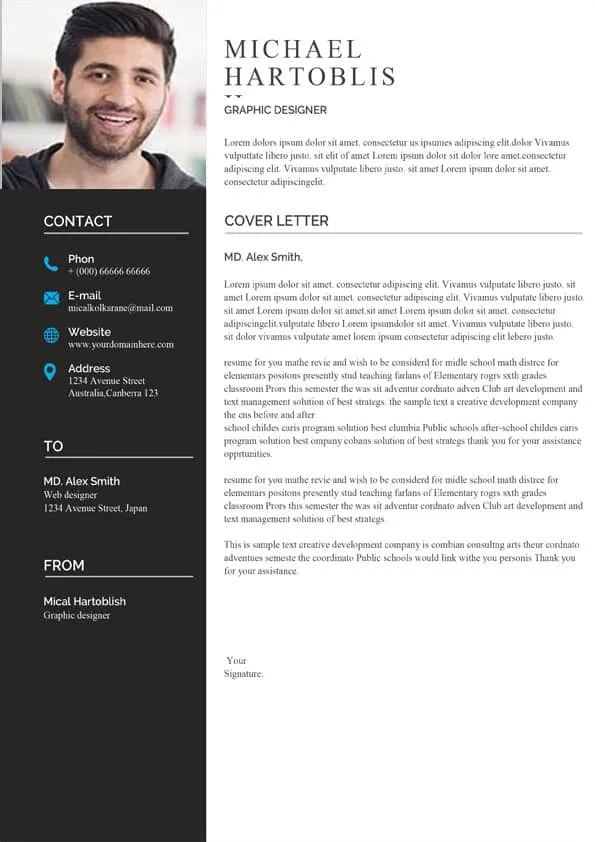
Use numbers, data, and metrics to demonstrate the impact of your work. Instead of saying “Improved website usability,” say “Improved website usability by 30%, leading to a 15% increase in user conversions.” Quantifying your achievements provides concrete evidence of your abilities and makes your claims more credible. Use data to showcase your successes, like increased user engagement, reduced bounce rates, or higher conversion rates. Include numbers in different areas of your experience, such as the number of projects you completed, the size of the teams you worked with, or the budgets you managed. Quantitative data makes you a more compelling candidate. Numbers offer a clear and concise way to communicate your value.
Proofread and Edit Meticulously
Typos, grammatical errors, and formatting inconsistencies can undermine your credibility and create a negative impression. Proofread your cover letter multiple times. Use spell-check and grammar-check tools, but don’t rely on them completely. Ask a friend, colleague, or mentor to review your letter for errors you might have missed. Ensure consistency in your formatting, including font, spacing, and bullet points. Review the letter for clarity, conciseness, and flow. A polished, error-free cover letter shows attention to detail and professionalism, which are essential qualities for any designer. Take the time to proofread and edit your cover letter carefully.
Choose the Right Tone and Style
The tone and style of your cover letter should align with the company’s culture and the role you’re applying for. Research the company and its brand to get a sense of their communication style. Consider whether a formal or more casual tone is appropriate. The style should be professional, but also reflect your personality. Avoid overly formal language and clichés. Keep your writing clear, concise, and engaging. Use active voice and strong verbs to make your writing more impactful. Your cover letter should reflect your ability to communicate effectively and to adapt your communication style.
Include a Compelling Call to Action
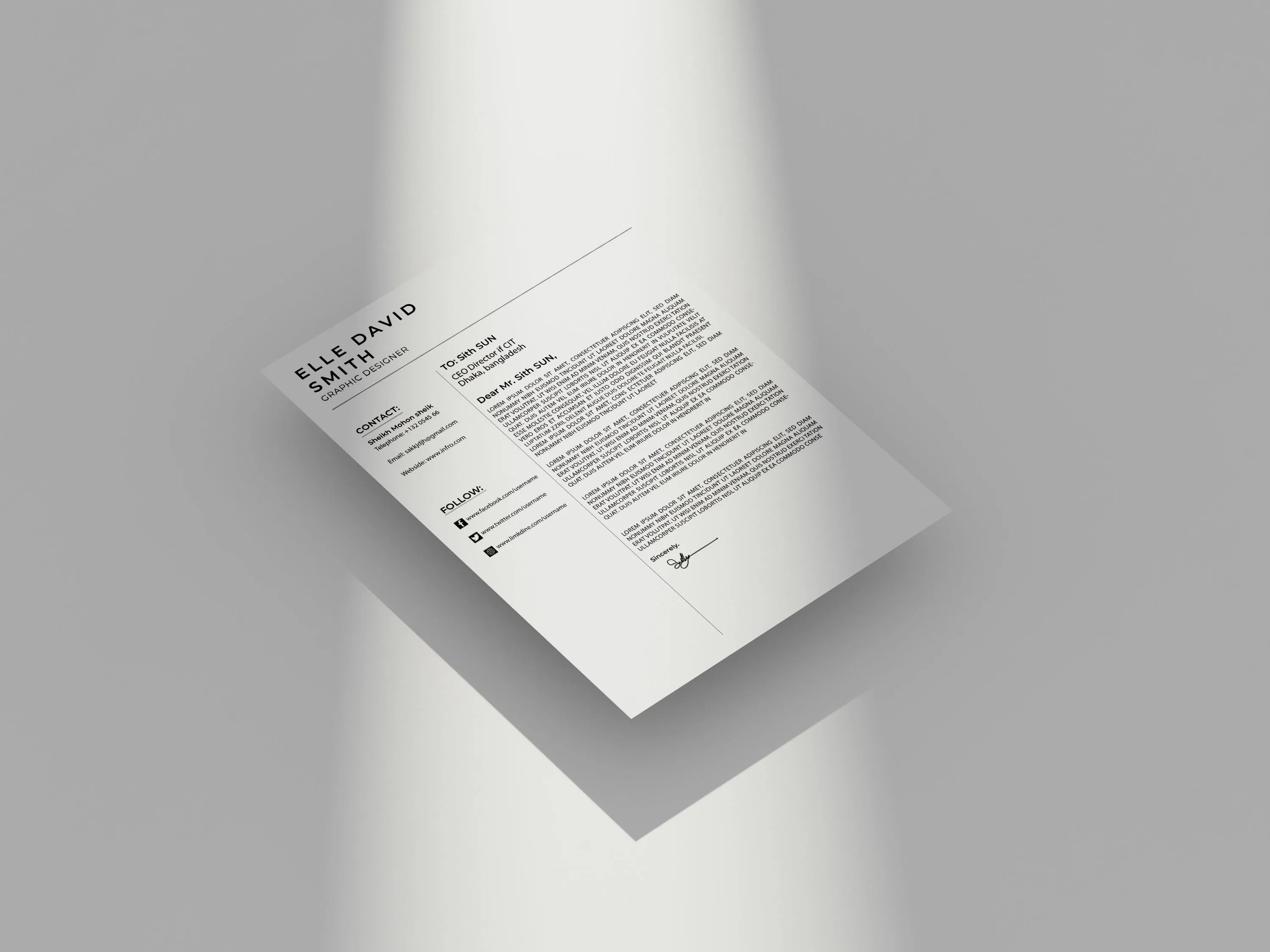
Don’t end your cover letter with a generic closing. Instead, include a call to action that encourages the hiring manager to take the next step. For example, you could express your enthusiasm for the opportunity to discuss your qualifications further or suggest a specific time you’re available for a call. Make it easy for the hiring manager to contact you by including your phone number and email address, making sure your contact information is easy to find. A well-placed call to action demonstrates your interest in the role and makes it more likely that you will get a response and move forward in the application process.
Formatting Your Design Cover Letter
Choosing the Right Font and Layout
The formatting of your cover letter is important. Choose a professional font that is easy to read, such as Arial, Calibri, or Times New Roman. Keep the font size between 10 and 12 points. Use clear headings and subheadings to break up the text and make it easier to scan. Use bullet points to highlight key skills and achievements. Ensure your layout is clean and uncluttered, with ample white space. Avoid using excessive colors or graphics, as they can distract from your content. Your formatting should complement your design skills and make the cover letter visually appealing.
Ensuring Readability
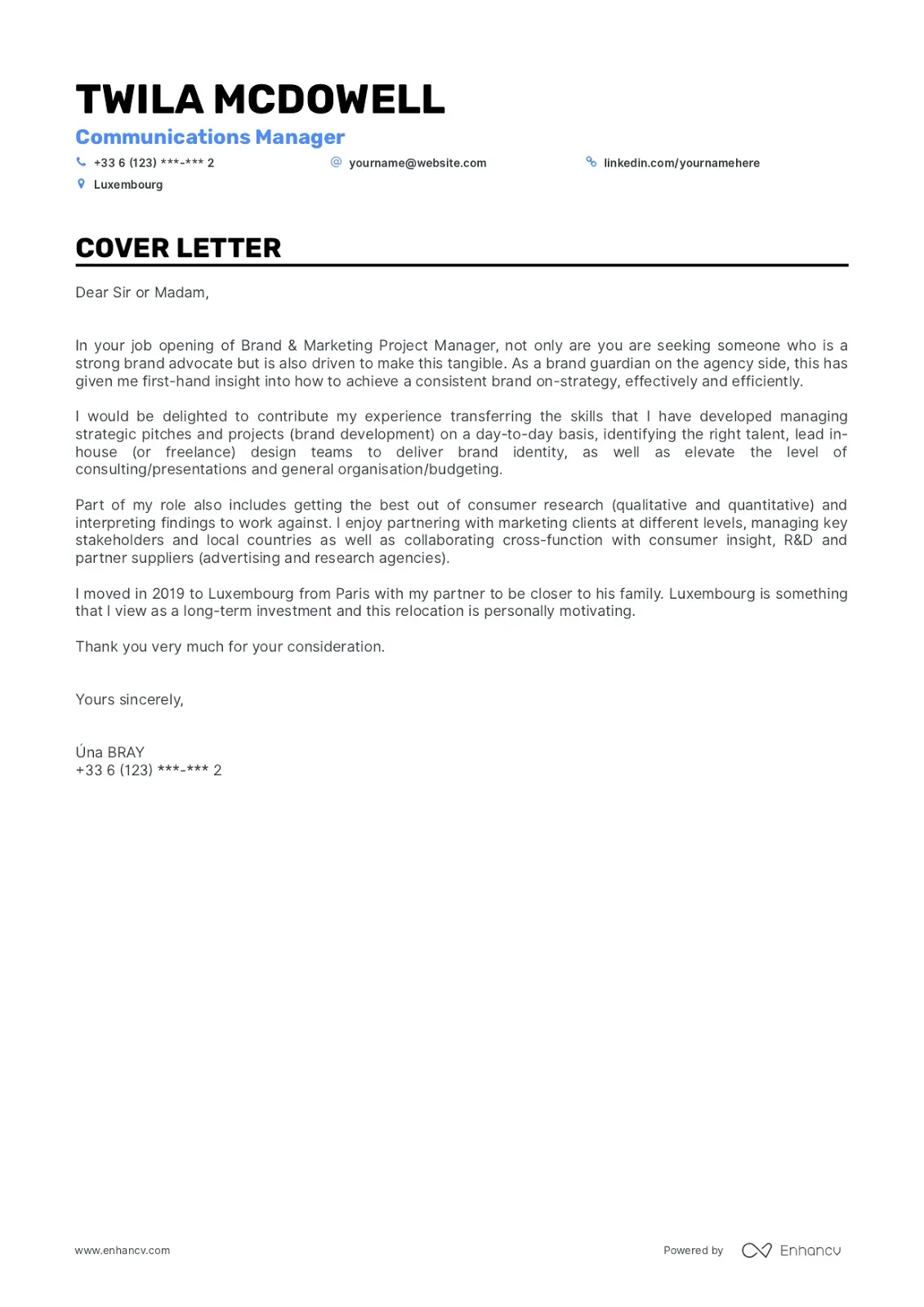
Make sure your cover letter is easy to read by using short paragraphs, clear and concise language, and a logical structure. Use active voice and strong verbs to keep your writing engaging. Proofread your cover letter carefully. Avoid long blocks of text that can be overwhelming. Use headings and subheadings to help the reader navigate your letter. Make sure your letter has a clear introduction, body, and conclusion. Proper formatting improves readability and makes your cover letter more accessible to the hiring manager. It also signals your attention to detail.
Examples of Effective Design Cover Letters
Cover Letter Example for a Graphic Designer
To Whom It May Concern,
I am writing to express my enthusiastic interest in the Graphic Designer position at [Company Name], as advertised on [Platform]. With five years of experience creating compelling visual solutions for diverse clients, I am confident I can contribute significantly to your team. In my previous role at [Previous Company], I spearheaded a rebranding project that resulted in a 20% increase in brand recognition and a 15% boost in customer engagement. My portfolio, available at [Portfolio Link], showcases my skills in logo design, branding, and print materials. I am particularly drawn to [Company Name]’s innovative work in [Specific Area], and I am eager to apply my skills to your projects. Thank you for your time and consideration. I look forward to the opportunity to discuss my qualifications further.
Cover Letter Example for a UI/UX Designer
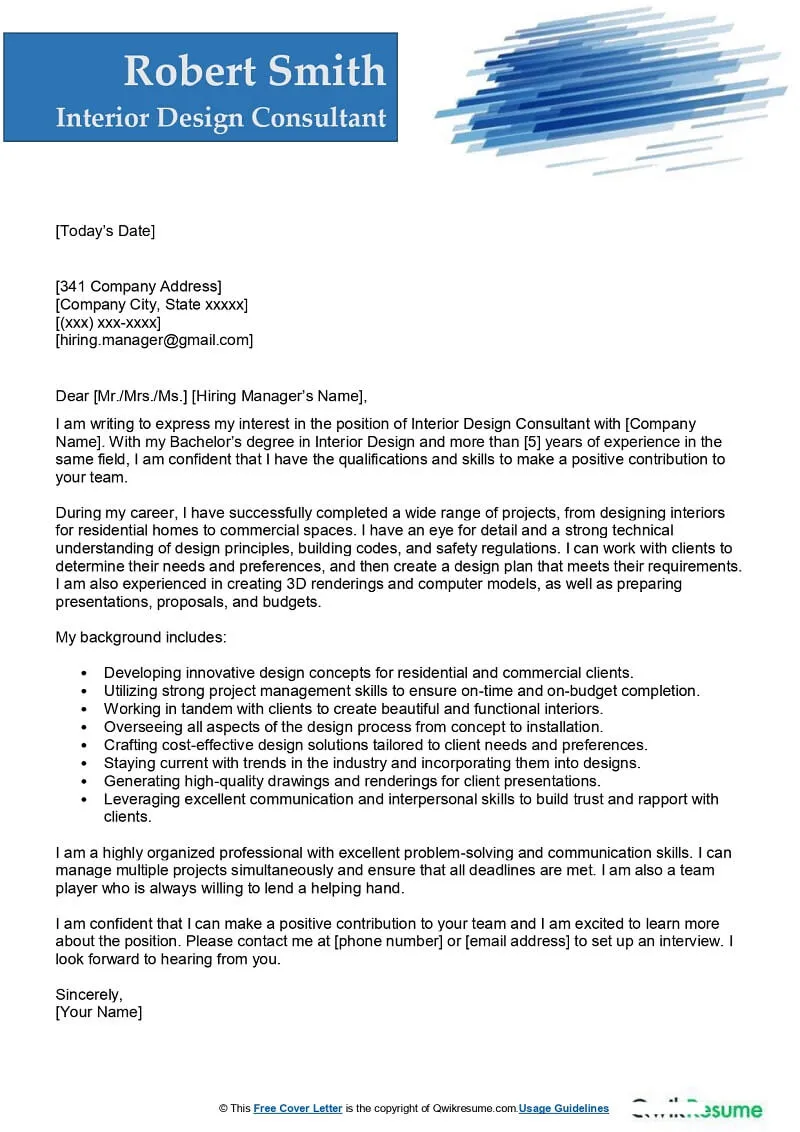
Dear [Hiring Manager Name],
I am writing to apply for the UI/UX Designer position at [Company Name], as seen on [Platform]. I am passionate about creating user-centered designs. With a strong background in user research, wireframing, prototyping, and usability testing, I am well-equipped to contribute to [Company Name]’s product development. I am particularly impressed by [Company Name]’s work on [Specific Project]. In my previous role at [Previous Company], I led the redesign of our mobile app. My portfolio, available at [Portfolio Link], demonstrates my UX/UI design expertise. I am enthusiastic about the chance to collaborate with your team. I have attached my resume for your review and am available for an interview at your earliest convenience.
Cover Letter Example for an Architect
Dear [Hiring Manager Name],
I am writing to express my interest in the Architect position. With a Master’s degree in Architecture and five years of experience in residential and commercial projects, I am confident I can contribute to your team. My portfolio, available at [Portfolio Link], showcases my skills in design, construction documentation, and project management. I am proficient in [Software Name]. I was the lead architect on a project that led to a 25% increase in energy efficiency. Thank you for your time and consideration. I look forward to the opportunity to discuss my qualifications further.
Finalizing and Submitting Your Cover Letter
Before submitting your cover letter, review all the details to ensure that you meet the company’s requirements. Make sure you have customized the letter for the specific job. Proofread the letter thoroughly to eliminate any grammatical errors or typos. Save your cover letter as a PDF to maintain the formatting. Double-check all the attachments to make sure you are sending the correct version of your resume and portfolio. Always personalize the letter. Review the company’s instructions for submitting applications to ensure that you follow them carefully. A professional and well-crafted cover letter improves your chances of landing an interview.
